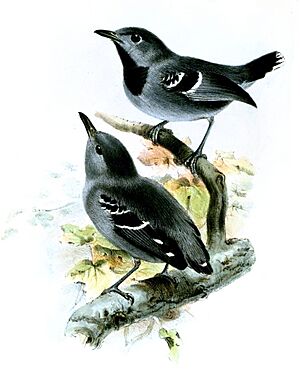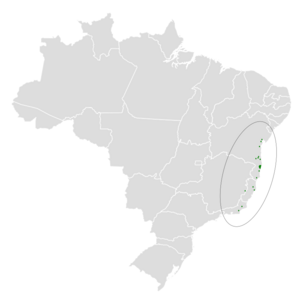Band-tailed antwren facts for kids
Quick facts for kids Band-tailed antwren |
|
|---|---|
 |
|
| Illustration (above) (lower bird Myrmotherula hauxwelli) | |
| Conservation status | |
| Scientific classification | |
| Genus: |
Myrmotherula
|
| Species: |
urosticta
|
 |
|
The band-tailed antwren (Myrmotherula urosticta) is a small bird that eats insects. It belongs to the "typical antbirds" family, called Thamnophilidae. This bird is a Vulnerable species, meaning it's at risk of disappearing. It lives only in Brazil.
Contents
About Its Name and Family
The band-tailed antwren was first described in 1857 by an English zoologist named Philip Sclater. He gave it the scientific name Formicivora urosticta.
This bird is "monotypic," which means it's the only species in its group. The band-tailed antwren and the long-winged antwren are very closely related. Scientists sometimes call them a "superspecies" because they are so similar.
What It Looks Like
The band-tailed antwren is a small bird, about 9 to 10 cm (3.5 to 3.9 in) long. It has a short tail.
Male band-tailed antwrens have gray feathers on their upper body. They have a hidden white patch between their shoulders. Their wings are gray with black feathers that have white tips. Their tail is a darker gray with a wide white band at the end, which is how the bird got its name. Their throat and upper chest are black, and the rest of their underside is a lighter gray.
Female band-tailed antwrens have a lighter gray face and upper body than the males. Their wing feathers are gray with white tips. Their throat is white, and their sides are gray. The rest of their underside is a pale cinnamon-buff color.
Where It Lives and What It Likes
The band-tailed antwren lives in the Atlantic Forest of Brazil. It is found in specific, small areas along the coast of eastern Brazil. You can find it between the states of Bahia and northern Rio de Janeiro. The most birds are found in southern Bahia and northern Espírito Santo.
This bird lives in the lower and middle parts of tall, evergreen forests. It also lives in older secondary forests, which are forests that have grown back after being cut down. It seems to prefer tall forests with sandy soil, especially those with many vines in the lower areas. It usually lives below about 500 m (1,600 ft) in elevation.
How It Behaves
Movement
Scientists believe the band-tailed antwren stays in the same area all year round. It does not migrate.
Feeding
We don't know all the details about what the band-tailed antwren eats. But it probably eats mostly insects and spiders. It hunts for food alone, in pairs, or with its family. Often, it joins a mixed-species feeding flock. This is a group of different bird species that hunt for food together.
The antwren usually looks for food on leafy branches that are fairly open. It mostly feeds between 3 and 10 m (10 and 30 ft) above the ground. Sometimes, it will go as high as 20 m (70 ft), but this is rare. It finds its prey by picking insects off live leaves. It also takes prey from dead leaves, tangled vines, and along branches. It does this by picking, reaching, lunging, or making short flights from a branch.
Breeding
We don't know anything about how the band-tailed antwren raises its young.
Vocalization
The band-tailed antwren's song is a short series of 4 to 5 high, nasal notes. They sound like "tjeuwi" and go up in pitch. Its most common call has three notes that drop in pitch.
Its Status
The IUCN (International Union for Conservation of Nature) has changed its assessment of the band-tailed antwren over time. Since 2004, it has been listed as a "Vulnerable" species. This means it faces a high risk of extinction in the wild.
There are an estimated 2,500 to 10,000 adult band-tailed antwrens left. Their population is spread out and divided into small groups. Scientists believe their numbers are decreasing. The biggest threat to these birds is habitat destruction. This means their forest homes are being cut down.
Most of the lowland Atlantic Forest where this bird used to live has been cleared. Even some of the protected areas where it lives are not completely safe. The band-tailed antwren is considered uncommon and lives in specific places. Even though it's found in five protected areas in southern Bahia, parts of these areas are not suitable for the bird. This means the actual safe space for them is much smaller than it seems.


